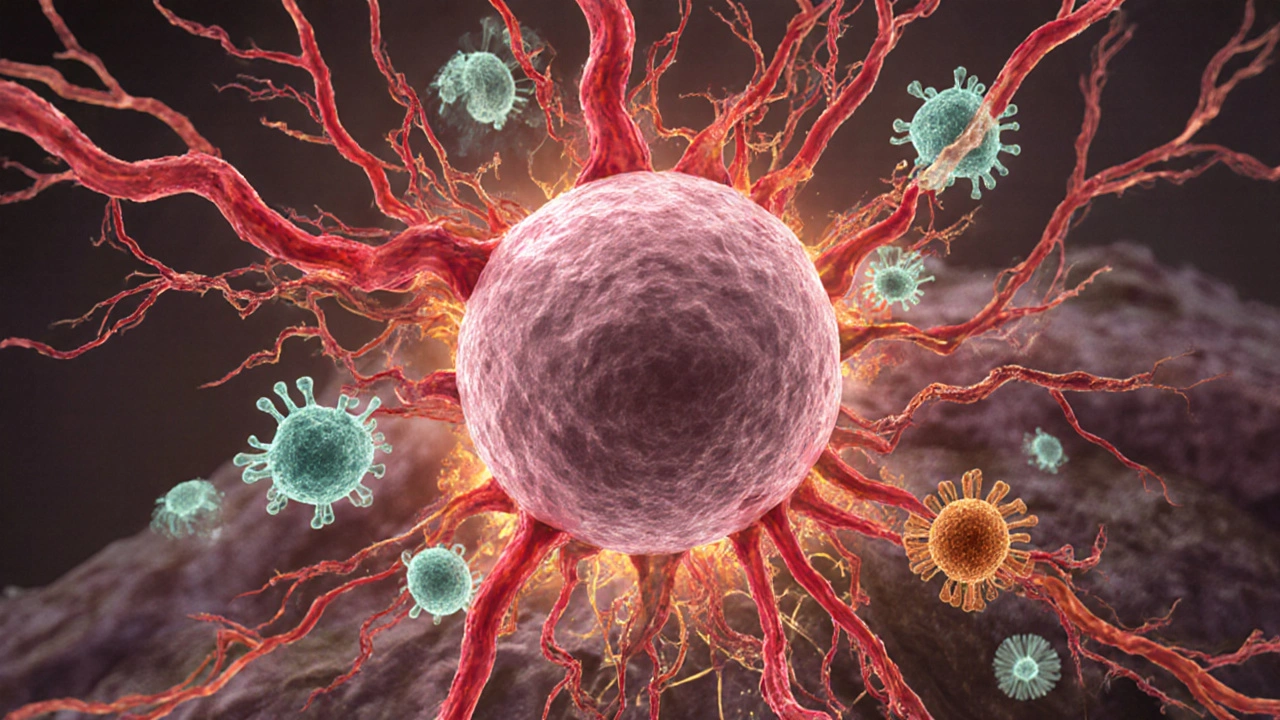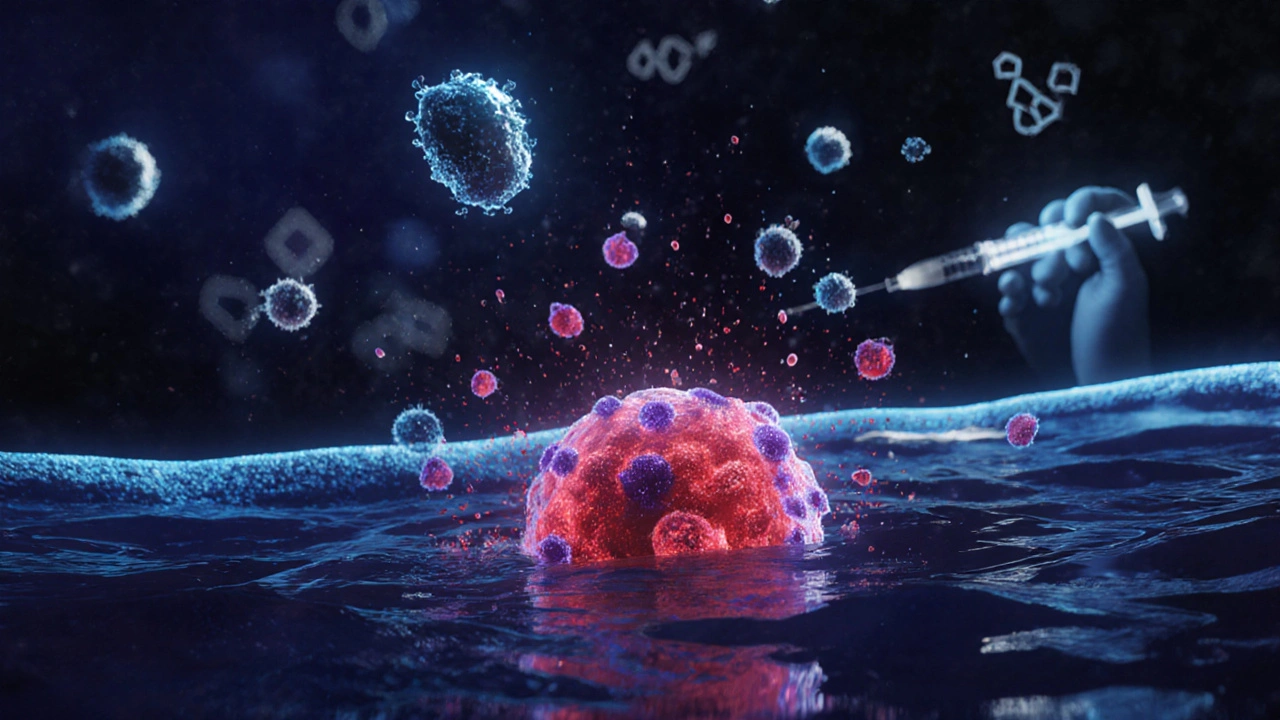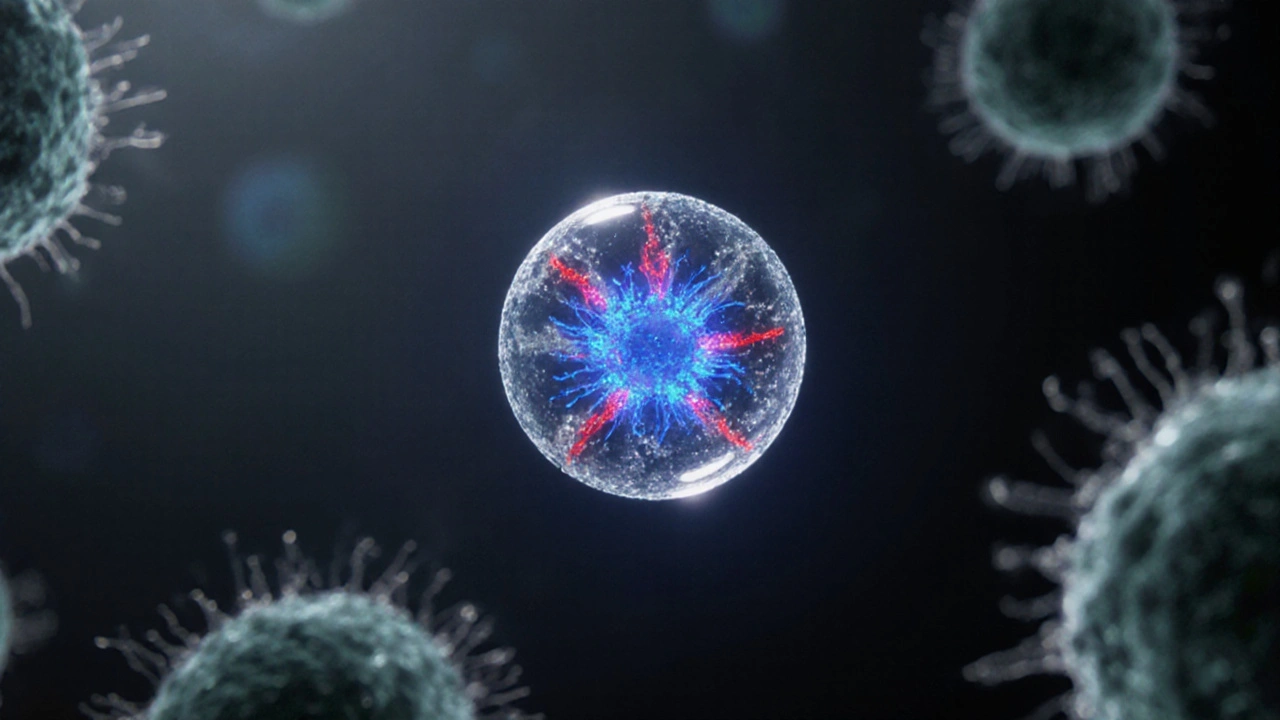Tumor Growth Simulator
Adjust the sliders and click "Simulate Tumor Progression" to see how different factors influence tumor behavior.
- Initiation: Genetic mutations trigger abnormal cell growth
- Promotion: Chronic inflammation and growth signals sustain expansion
- Progression: Angiogenesis supports rapid tumor growth
- Metastasis: Cancer cells spread to distant organs
Ever wondered why some lumps stay tiny while others explode into dangerous masses? The answer lies in the complex biology of tumor growth. Below we break down the science step by step, from rogue cells to the networks that feed them, so you can see what really drives cancer forward.
Key Takeaways
- Tumor growth is fueled by genetic mutations that hijack the normal cell‑cycle.
- Angiogenesis supplies the oxygen and nutrients a tumor needs to expand.
- The tumor microenvironment and immune evasion let cancer cells hide and thrive.
- Metastasis spreads cancer to new organs, dramatically worsening prognosis.
- Modern therapies target each of these steps, turning biology into treatment options.
What Exactly Is Tumor Growth?
Tumor growth is the process by which abnormal cells multiply, form a mass (tumor), and often acquire the ability to invade nearby tissues. In everyday language, a tumor can be benign (non‑cancerous, usually slow‑growing) or malignant (cancerous, aggressive, and capable of spreading). Malignant tumors are what most people refer to when they talk about cancer.
While a single mutated cell can start the process, its expansion depends on how it interacts with surrounding cells, blood vessels, and the immune system. Understanding these interactions is the key to decoding why some cancers stay localized and others become deadly.
Cellular Machinery Gone Rogue
Every cell follows a tightly regulated cycle of growth, DNA replication, and division. Cancer hijacks this schedule through two main types of genetic changes:
- Oncogenes are mutated versions of normal genes (proto‑oncogenes) that push cells to divide faster than they should.
- Tumor suppressor genes normally act as brakes. When these brakes break, cells lose the ability to stop growing.
Common examples include the KRAS oncogene, which drives many pancreatic cancers, and the TP53 tumor suppressor, called the “guardian of the genome.” When TP53 is knocked out, DNA errors pile up, accelerating tumor growth.
These genetic flips also affect cell division timing, allowing cancer cells to skip the normal checkpoints that prevent damaged DNA from replicating.
Angiogenesis: Building the Tumor’s Lifeline
Imagine trying to grow a city without roads or utilities-impossible, right? Tumors face the same problem. They need blood to bring oxygen and nutrients. This need triggers angiogenesis, the sprouting of new blood vessels from existing ones.
The primary driver is a protein called Vascular Endothelial Growth Factor (VEGF). Cancer cells release VEGF, which binds to receptors on nearby endothelial cells, telling them to proliferate and form capillary networks. These new vessels are often leaky, creating a chaotic environment that actually helps cancer cells spread.
Blocking VEGF with drugs like bevacizumab has shown that cutting off the blood supply can shrink tumors, confirming how central angiogenesis is to tumor growth.

The Tumor Microenvironment and Immune Evasion
Surrounding the mass of cancer cells is a bustling community called the tumor microenvironment. It includes fibroblasts, immune cells, extracellular matrix, and signaling molecules. This environment can be either a friend or foe to the tumor.
Many cancers manipulate immune cells to become tolerant. For instance, they attract regulatory T‑cells (Tregs) that suppress the attack of cytotoxic T‑cells. They also express PD‑L1, a “do‑not‑attack” signal that tricks the immune system into standing down.
Because of these tactics, tumors can grow unchecked even when the body’s defenses are otherwise strong. Immunotherapies such as checkpoint inhibitors aim to lift these brakes, re‑engaging the immune system against the tumor.
Metastasis: The Deadly Spread
While a primary tumor can be problematic on its own, the real danger often comes from metastasis-the process where cancer cells break away, travel through the bloodstream or lymphatic system, and seed new sites.
Metastatic cells undergo an epithelial‑to‑mesenchymal transition (EMT), gaining mobility and resistance to apoptosis. Once at a new organ, they adapt to the local microenvironment, often forming secondary tumors that are harder to treat.
Statistically, about 90% of cancer‑related deaths are linked to metastatic disease, underscoring why understanding this step is crucial for any discussion of tumor growth.
Key Drivers of Rapid Tumor Expansion
Many factors can tip the balance toward faster growth. Below is a concise look at the most common drivers, the mechanisms they employ, and the cancers where they appear most often.
| Factor | Primary Mechanism | Typical Impact | Example Cancer |
|---|---|---|---|
| DNA Mutations | Activate oncogenes / disable tumor suppressors | Increases proliferation rate | Lung adenocarcinoma |
| Hypoxia | Stabilizes HIF‑1α, upregulates VEGF | Boosts angiogenesis | Glioblastoma |
| Chronic Inflammation | NF‑κB activation, cytokine release | Enhances survival signals | Colorectal cancer |
| Immune Checkpoint Expression | PD‑L1/CTLA‑4 signaling | Suppresses cytotoxic T‑cell activity | Melanoma |
| Metabolic Reprogramming | Warburg effect (aerobic glycolysis) | Provides rapid energy for division | Breast cancer |
Targeting Growth Pathways with Modern Therapies
Knowing how tumors grow gives doctors a roadmap for treatment. Here’s how the major steps are being hit by current drugs:
- Cell‑cycle inhibitors (e.g., CDK4/6 blockers) directly slow down uncontrolled division.
- Anti‑angiogenic agents like bevacizumab starve the tumor by cutting off new blood‑vessel formation.
- Immune checkpoint inhibitors (pembrolizumab, nivolumab) lift the PD‑L1 brakes, allowing T‑cells to attack.
- Targeted kinase inhibitors (erlotinib for EGFR‑mutated lung cancer) block specific oncogenic signaling pathways.
- Metastasis‑blocking strategies are emerging, aiming at EMT regulators and adhesion molecules.
By combining these approaches-often called “precision medicine”-clinicians can attack the tumor from multiple angles, slowing or even reversing growth.
Putting It All Together
Tumor growth isn’t a single event; it’s a cascade of genetic missteps, environmental adaptations, and clever evasion tactics. From the first DNA error to the final metastatic spread, each stage offers a chance for intervention. When you grasp the science behind it, the scary term “cancer” becomes a series of logical steps you can understand-and, more importantly, target.

Frequently Asked Questions
Why do some tumors stay small while others grow quickly?
Growth speed depends on the combination of genetic mutations (e.g., active oncogenes), the ability to recruit blood vessels (angiogenesis), and how well the tumor evades the immune system. Tumors lacking these advantages tend to remain indolent.
Can blocking angiogenesis stop cancer completely?
Anti‑angiogenic drugs can shrink tumors and delay progression, but cancer often finds alternative pathways or becomes resistant. They’re most effective when combined with other therapies.
What role does inflammation play in tumor growth?
Chronic inflammation releases cytokines that activate NF‑κB and other survival pathways, creating a fertile ground for DNA damage and supporting tumor cell proliferation.
How does the tumor microenvironment affect treatment outcomes?
A supportive microenvironment can shield cancer cells from drugs and immune cells, reducing efficacy. Modifying the microenvironment-such as using stroma‑targeting agents-can improve response rates.
What is the difference between an oncogene and a tumor suppressor gene?
Oncogenes are like a stuck accelerator, pushing cells to divide, while tumor suppressor genes act as brakes. Mutations that turn on oncogenes or turn off tumor suppressors both lead to uncontrolled growth.


josue rosa
October 5, 2025 AT 02:44The delineation of tumorigenic pathways necessitates an integrative appreciation of oncogenic driver mutations, loss‑of‑function alterations in tumor suppressor loci, and the resultant dysregulation of cell‑cycle checkpoint fidelity. In the canonical model, activation of proto‑oncogenes such as KRAS or MYC furnishes a proliferative impetus that converges upon cyclin‑dependent kinase (CDK) hyperactivity, thereby truncating the G1‑S transition. Concurrently, inactivation of TP53 or RB1 disarms the genomic surveillance apparatus, permitting the accrual of additional somatic aberrations without triggering apoptotic cascades. Angiogenic sprouting, orchestrated predominantly by vascular endothelial growth factor (VEGF) signaling, engenders a neo‑vascular lattice that mitigates hypoxic stress and supplies requisite metabolites for exponential tumor expansion. Moreover, the tumor microenvironment (TME) exerts reciprocal modulation through fibroblast activation, extracellular matrix remodeling, and immune cell polarization toward an immunosuppressive phenotype via PD‑L1 expression and regulatory T‑cell recruitment. These interdependent mechanisms culminate in the epithelial‑to‑mesenchymal transition (EMT), imbuing malignant cells with migratory capacity and resistance to anoikis, thereby facilitating hematogenous dissemination. Metastatic colonization further exploits organ‑specific niche conditioning, wherein seeding cells co‑opt resident stromal cues to establish secondary proliferative foci. Therapeutically, this intricate circuitry is interrogated at multiple nodes: CDK4/6 inhibitors restore checkpoint control, bevacizumab attenuates angiogenic flux, and checkpoint blockade reinvigorates cytotoxic T‑lymphocyte activity. Precision oncology thus mandates a multilayered stratagem, integrating genomic profiling with functional assays to tailor interventions that interrupt the tumor’s proliferative and invasive circuitry. Ultimately, a comprehensive grasp of these molecular cascades enables clinicians to convert ostensibly inexorable tumor progression into a tractable, therapeutically vulnerable process.
Angie Wallace
October 21, 2025 AT 14:44Great breakdown, keep it up
Doris Montgomery
November 7, 2025 AT 02:44This article feels like a textbook rewrite with no new insight.
Nick Gulliver
November 23, 2025 AT 14:44Our country's research should lead the world, not these foreign theories.